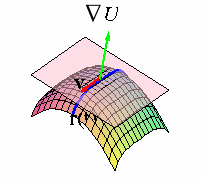Surface Normals and Tangent Planes to Level Surfaces
Because the equation of a plane requires a point and a normal vector to the
plane, finding the equation of a tangent plane to a surface at a given point
requires the calculation of a surface normal vector. In this section, we explore
the concept of a normal vector to a surface and its use in finding equations of
tangent planes.
To begin with, a level surface U( x,y,z) = k is said to be smooth if
the gradient ÑU =
áUx,Uy,Uz
ñ is continuous and non-zero at each point on the surface.
Equivalently, we often write
the gradient as
where ex =
á 1,0,0
ñ , ey =
á 0,1,0
ñ , and ez =
á0,0,1
ñ .
Suppose that r( t) =
á x( t), y(t), z( t)
ñ is a curve that lies on a smooth surface U(x,y,z) = k. Applying the derivative with respect to t to both sides
of the equation of the level surface yields
Since k is a constant, the chain rule implies that
where v =
á x' (t), y' (t), z' (t)
ñ. However, v
is tangent to the surface because it is tangent to a curve on the surface,
which implies that ÑU is orthogonal to each tangent vector v at a given point on the surface.
 |
|
click image to toggle animation |
|
That is, ÑU(p,q,r) at a given point (p,q,r) is normal to the tangent plane
to the surface U( x,y,z) = k at the point (p,q,r).
We thus say that the gradient ÑU is normal to the surface U(x,y,z) = k
at each point on
the surface.
EXAMPLE 1 Find the equation of the tangent plane to the
hyperboloid in 2 sheets
at the point ( 3,2,1) .
Solution: To begin with, we identify U( x,y,z) = x2-y2-z2, so that its gradient is
As a result, at the point ( 3,2,1 ) a normal to the tangent
plane is given by
|
n = ÑU( 3,2,1) =
á 6,-4,-2
ñ |
|
It follows that the equation of the tangent plane is
|
6( x-3) -4( y-2) -2( z-1) = 0 |
|
which simplifies to the equation z = 3x-2y-4.
EXAMPLE 2 Find the equation of the tangent plane to the
right circular cone
at the point (0.6, 0.8, 1) .
Solution: Since the equation of the surface can be written x2+y2-z2 = 0, we let U( x,y,z) = x2+y2-z2. As a
result, the gradient of U is
At the point ( 0.6, 0.8, 1) , a normal vector is ÑU =
á 1.2, 1.6, -2
ñ , so that the equation of the tangent
plane is
|
1.2( x-0.6) +1.6( y-0.8) -2( z-1) = 0 |
|
Solving for z then yields z = 0.6x + 0.8y, which is
shown in the figure below:
Check your Reading: What
degenerate conic section is formed by the intersection of the cone with
the tangent plane in example 3?
